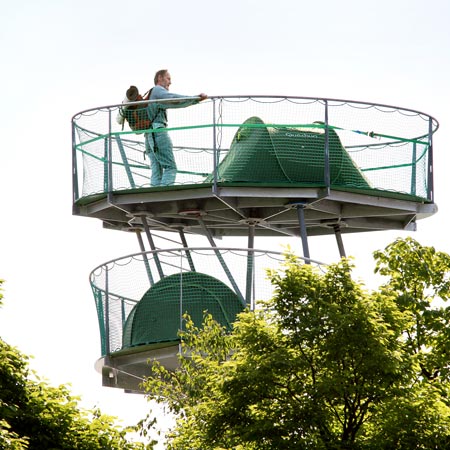Belgian architects import.export have created a mobile multi-storey structure that allows people to camp in urban areas.
Urban Camping is a steel structure supporting four platforms on which tents can be pitched.
The structure was inaugurated in Antwerp last month and will move temporarily to Copenhagen next month.
Images are copyright Filip Dujardin/OWI and used with permission.
Here's some text about Urban Camping:
--
Camping is defined as 'getting away from an urban area, and enjoying nature, spending one or more nights on a location'. As such, the phrase Urban Camping contradicts itself.
import.export ARCHITECTURE (Oscar Rommens en Joris Van Reusel, architecten) designed a new type of ‘small scale’ urban camping. The mobile UC can be implanted in any city centre that likes to experiment with this new type of camping. UC is a place where adventurous city wanderers can stay overnight, meet other campers and find a safe shelter with basic designed practical facilities.
From 24th April until 24th May 2009, UC was constructed for the first time on the Antwerp shores of the Scheldt, for the Kaailand Festival exhibition on mobile architecture.
This summer, UC will have a temporary resurrection by the Antwerp tourist service in Copenhagen, for the occasion of the project OUTCITIES from 25th July until 1st August, to promote the city of Antwerp and its innovative policy in terms of tourism.
(English version)
UC / URBAN CAMPING
Project description
Camping is defined as getting away from an urban area, and enjoying nature, spending one or more nights on a location. (1) As such, the phrase urban camping contradicts itself.
Urban camping informally and unexpectedly revealed itself in examples such as parents camping in front of a school to enroll their kids or Harry Potter fans camping in front of a store to buy the newest release.
A new interest in city traveling has sparked a rise in low-budget traveling accommodation requiring a rethinking of urban visitor sleeping solutions. Existing low budget hotels, but also contemporary youth hostels are a limited and often poor answer to this general demand for cheap lodging in the city-centers. On the other hand, campers trying to visit cultural city centers on their drifting routes, often encounter camping areas located in the city’s anonymous expanding outer limits.
IEA wants to setup an experimental process of research and design around this topic. The first results of this ongoing study where presented in the exhibition, ‘It’s about time Expo 2030’ last summer at the Designcenter De Winkelhaak in Antwerp. The exposed material was mainly focusing on analyzing the phenomena of urban camping and trying to relate it to other topics such as: temporal territories, vertical staging of landscapes, multiple readings and interpretations on urban green and their potentials.
As a synthesis IEA presented a proposal for a new type of ‘small scale’ urban camping, DC/UC I (2) , that was supposed to be erected in the courtyard of the Designcenter and tried out for 2 months by visitors of the exhibition. Unfortunately this was not fulfilled due to time limitations.
Now IEA wants to pursue this reality-check, scale 1:1, in the public realm. A second generation and more refined model of the UC is designed and ready to be realized. For the KAAILAND Festival exposition (3) on mobile Architecture, SK/UC II (4) is build on the Antwerp quays near the river Schelde.
This type can be implanted in any city centre that likes to experiment with this new type of urban camping. That is open to create a place for local and international travelers that are welcomed to stay for an ‘escape’ into rather than away from the city life. To create a place where adventurous city wanderers can stay overnight, meet other campers, find a safe shelter with basic designed practical facilities focusing on extraordinary vistas of city exploration.
UC II is a part of a larger global investigation, repurposing existing territories for camping and designing shelters tailored to the urban environment.
UC / DESIGN PRINCIPALS
For designing and implementing an urban camping
° UC is erected as a vertical growing landscape: due to a lack of disposable open wide green space in the city
° UC is a three dimensional stacking of campgrounds : it generates different experiences and fascinating vistas
° UC is a durable and self sustaining (=autarctic) entity
° UC exist out of minimum 3 and maximum 8 layers of camping grounds
° UC residing tents are always positioned in the open air on a hired privatised platform
° UC circulation is weaved in the supportive structure and restricted in safety and accessibility
° UC is seen as a successive structure : it encourages the personalisation of the place by the camper and allows
individual or collective additives to the structure - however no structural transformations are allowed.
° UC is a positive surplus and enrichment for it surroundings ( spatial, light, social, ecological, economical, esthetical )
° UC respects the rules that every individual should be able to enjoy the qualities of light and sight without disturbing
it’s surroundings
° UC platforms are each positioned to generate social interaction between travelling users and its sedentary
neighbours
° UC is a specific generic but could evolve towards a unique identity, it adapts itself depending to the surroundings
but is not a parasite
import.export ARCHITECTURE
Oscar Rommens and Joris Van Reusel
May 12th 2008, Antwerp
-------
(1) source: wikipedia
(2) DC/UC I: Designcenter / Urban Camping I, Antwerp, june-august 2008
(3) KAAILAND Festival, Kaailand Zuid, Antwerp, from 24/04 till 29/05/2009, www.kaailand.be
(4) SK/UC II: Scheldekaaien / Urban Camping II

